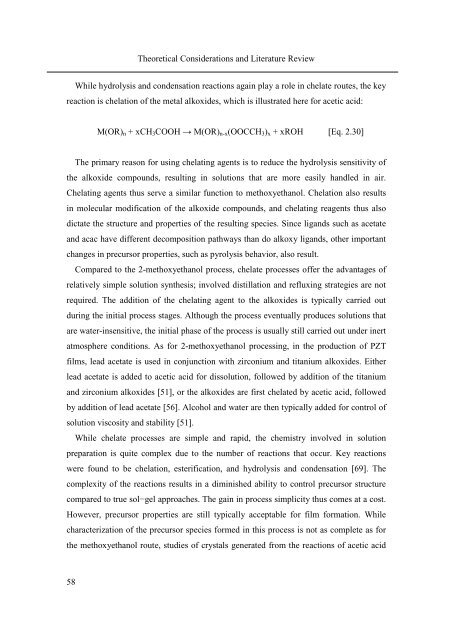PhD Thesis Arne Lüker final version V4 - Cranfield University
PhD Thesis Arne Lüker final version V4 - Cranfield University
PhD Thesis Arne Lüker final version V4 - Cranfield University
Create successful ePaper yourself
Turn your PDF publications into a flip-book with our unique Google optimized e-Paper software.
58<br />
Theoretical Considerations and Literature Review<br />
While hydrolysis and condensation reactions again play a role in chelate routes, the key<br />
reaction is chelation of the metal alkoxides, which is illustrated here for acetic acid:<br />
M(OR)n + xCH3COOH → M(OR)n-x(OOCCH3)x + xROH [Eq. 2.30]<br />
The primary reason for using chelating agents is to reduce the hydrolysis sensitivity of<br />
the alkoxide compounds, resulting in solutions that are more easily handled in air.<br />
Chelating agents thus serve a similar function to methoxyethanol. Chelation also results<br />
in molecular modification of the alkoxide compounds, and chelating reagents thus also<br />
dictate the structure and properties of the resulting species. Since ligands such as acetate<br />
and acac have different decomposition pathways than do alkoxy ligands, other important<br />
changes in precursor properties, such as pyrolysis behavior, also result.<br />
Compared to the 2-methoxyethanol process, chelate processes offer the advantages of<br />
relatively simple solution synthesis; involved distillation and refluxing strategies are not<br />
required. The addition of the chelating agent to the alkoxides is typically carried out<br />
during the initial process stages. Although the process eventually produces solutions that<br />
are water-insensitive, the initial phase of the process is usually still carried out under inert<br />
atmosphere conditions. As for 2-methoxyethanol processing, in the production of PZT<br />
films, lead acetate is used in conjunction with zirconium and titanium alkoxides. Either<br />
lead acetate is added to acetic acid for dissolution, followed by addition of the titanium<br />
and zirconium alkoxides [51], or the alkoxides are first chelated by acetic acid, followed<br />
by addition of lead acetate [56]. Alcohol and water are then typically added for control of<br />
solution viscosity and stability [51].<br />
While chelate processes are simple and rapid, the chemistry involved in solution<br />
preparation is quite complex due to the number of reactions that occur. Key reactions<br />
were found to be chelation, esterification, and hydrolysis and condensation [69]. The<br />
complexity of the reactions results in a diminished ability to control precursor structure<br />
compared to true sol−gel approaches. The gain in process simplicity thus comes at a cost.<br />
However, precursor properties are still typically acceptable for film formation. While<br />
characterization of the precursor species formed in this process is not as complete as for<br />
the methoxyethanol route, studies of crystals generated from the reactions of acetic acid

















